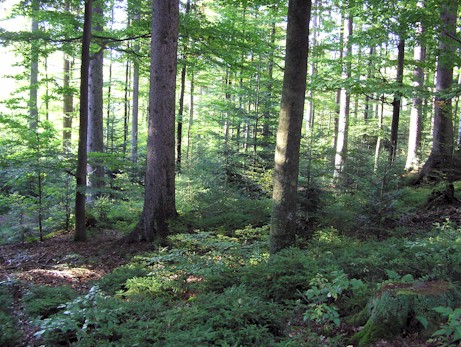 Example for a permanent study plots: B1 in Bodenmais, a mixed mountain forest with predominantly old spruce stands
Example for a permanent study plots: B1 in Bodenmais, a mixed mountain forest with predominantly old spruce stands
The variability of soil properties, nutrients and pollutants in forest ecosystems is considerable in both the horizontal and vertical directions. In order to assess changes in various parameters and conditions, it is necessary to collect data that representatively reflect the situation in the area. In forestry in particular, repeated sampling is preferably carried out on defined test areas, which are also referred to as permanent sample plots.
Long-term test plots are an essential part of long-term radio-ecological and of course ecological research programs. They enable direct insights into the dynamics of radionuclides in vegetation and in the soil. Time series data are critical to the development and validation of radioecological process models.
To determine the migration behavior of radionuclides, it is only useful to take soil samples (e.g. with a drill stick) from such permanent study plots.
In ecology: predictions of how forests will change over time and respond to climate change, biotic invasions, hurricanes and land management must be based on long-term observations.
Criteria for the selection and size of permanent sample plots
Sample areas that are sampled at regular intervals should represent the properties of the investigation area. This applies to both the aboveground and the underground compartments, i.e. the vegetation and the soil.
The size of the areas depends on the question. In Germany, long-term test areas measuring 50m x 50m or 100m x 100m are common.
If sample areas in forest ecosystems are used for decades, the location conditions can change compared to the initial situation. The vegetation and the composition of the tree species can change, which in turn influences the light conditions on the ground. This can lead to changes in the humus horizons.
The FAO determines the forest areas of the federal states at 5-year intervals, special investigations are carried out by the organization on permanent test areas.
Own research
As part of various research projects on the dynamics of cesium 137 and potassium 40 in different forest compartments, Umweltanalysen.com set up 100m x 100m long-term test areas in several federal states. In particular, the migration of radiocesium in the forest floor and vegetation was investigated on these. Deer truffles were also sampled in the longer term.
Literature
Bakker et al. 1996: Why Do We Need Permanent Plots in the Study of Long-Term Vegetation Dynamics?
Bundesforschungszentrum für Wald – Probeflächen bei Waldinventuren zur Erhebung der Biodiversität
Arctic Monitoring and Assessment Programme (AMAP) – Lichens obtained from permanent study plots as bioindicators for radioactive fallout
